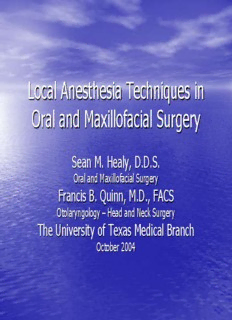
Local Anesthesia Techniques in Oral and Maxillofacial Surgery PDF
Preview Local Anesthesia Techniques in Oral and Maxillofacial Surgery
Local Anesthesia Techniques in Oral and Maxillofacial Surgery Sean M. Healy, D.D.S. Oral and Maxillofacial Surgery Francis B. Quinn, M.D., FACS Otolaryngology – Head and Neck Surgery The University of Texas Medical Branch October 2004 Overview: • Purpose of local anesthesia • Anatomy of maxillary and mandibular nervous innervation • Techniques of local anesthesia blocks • Commonly used local anesthetics • Complications with local anesthesia Local Anesthetics: • Role: – Decrease intraoperative and postoperative pain – Decrease amount of general anesthetics used in the OR – Increase patients cooperation – Diagnostic testing/examination Anatomical considerations: • Trigeminal nerve: – Sensory divisions: • Ophthalmic division V1 • Maxillary division V2 • Mandibular division V3 – Motor division: • Masticatory- masseter, temporalis, medial and lateral pterygoids • Mylohyoid • Anterior belly of the digastric • Tensor tympani • Tensor veli palatini Maxillary Division (V2): • Exits the cranium via foramen rotundum of the greater wing of the sphenoid • Travels at the superior most aspect of the pterygopalatine fossa just posterior to the maxilla • Branches divided by location: – Inter-cranial – Pterygopalatine – Infraorbital – Facial Maxillary Division (V2): • Branches: – Within the cranium- middle meningeal nerve providing sensory innervation to the dura mater – Within the pterygopalatine fossa- • Zygomatic nerve • Pterygopalatine nerves • Posterior superior alveolar nerve Maxillary Division (V2): • Within the pterygopalatine fossa- – Zygomatic nerve: • Zygomaticofacial nerve- skin to cheek prominence • Zygomaticotemporal nerve- skin to lateral forehead – Pterygopalatine nerves: • Serves as communication for the pterygopalatine ganglion and the maxillary nerve • Carries postganglionic secretomotor fibers through the zygomatic branch to the lacrimal gland
Description: